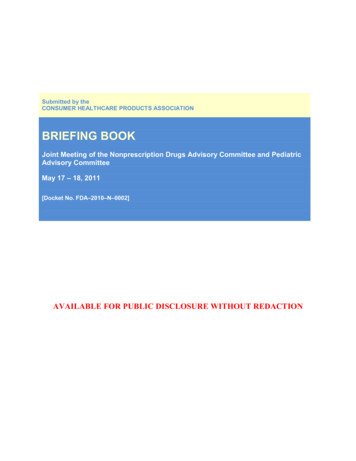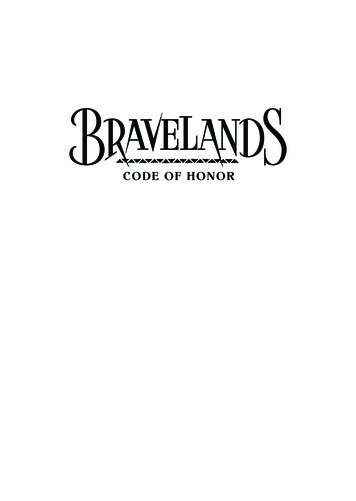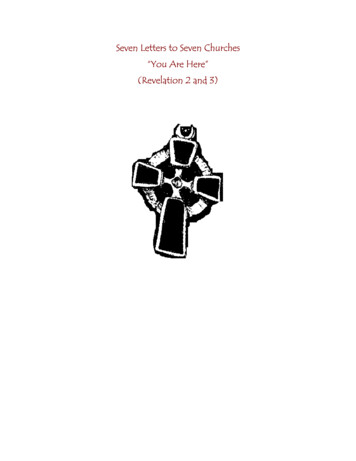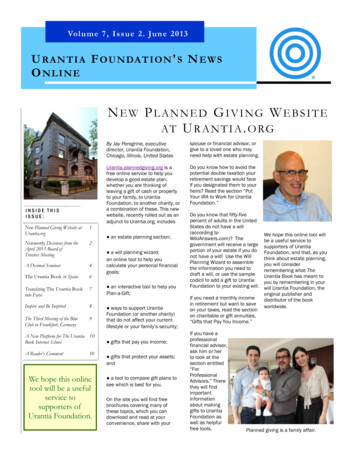
Transcription
Submitted by theCONSUMER HEALTHCARE PRODUCTS ASSOCIATIONBRIEFING BOOKJoint Meeting of the Nonprescription Drugs Advisory Committee and PediatricAdvisory CommitteeMay 17 – 18, 2011[Docket No. FDA–2010–N–0002]AVAILABLE FOR PUBLIC DISCLOSURE WITHOUT REDACTION
BRIEFING BOOKMeeting of the FDA Nonprescription Drugs Advisory Committeeand Pediatric Advisory CommitteeMay 17 – 18, 2011Docket No. 2011N-0002TABLE OF CONTENTSExecutive SummaryPage 3 - 7Recommendations by Medical AssociationsPage 8 - 10Use of Acetaminophen in ChildrenPage 11Root Causes of Medication Errors (UnsupervisedIngestions and Therapeutic Errors)Page 12 - 13CHPA Member Commitments and Actions to ReduceUnsupervised Ingestions and Therapeutic ErrorsPage 14 - 15Minimizing Accidental Unsupervised Medicine IngestionsPage 16 - 18CHPA Educational Activities Regarding AcetaminophenPage 19 - 23ReferencesPage 24 - 262
EXECUTIVE SUMMARYIntroductionOn March 9, 2011, FDA announced a joint meeting of the Nonprescription Drugs AdvisoryCommittee and the Pediatrics Advisory Committee to discuss use of over-the-counter (OTC)acetaminophen in children (Federal Register 2011). FDA intends to review pertinentpharmacokinetic, safety and efficacy data, and discuss whether new dosing information for OTCacetaminophen products should be added to the label for children less than 2 years of age.According to FDA’s announcement, the committees will also discuss weight-based dosing forchildren 2 to 12 years of age. Lastly, the committees will discuss ways medication errors can beminimized.Consumer Healthcare Products Association (CHPA) is the national trade association representingthe leading manufacturers and distributors of OTC medicines and dietary supplements in theUnited States. CHPA’s members manufacture and distribute OTC acetaminophen singleingredient products for children and adults. CHPA supports inclusion of dosing informationfor children less than 2 years of age on labels of OTC single-ingredient acetaminophenproducts intended for children, and the amendment of the OTC Internal AnalgesicsMonograph to reflect this labeling. Further, our members also support dosing based onweight as the preferred method for dosing children, and inclusion of this dosinginformation in the OTC Internal Analgesics Monograph.A priority goal of CHPA is to ensure that parents and caregivers have access to the bestmedicines possible, as well as informational resources to use them safely, appropriately, and in acost-effective manner. CHPA has an interest and expertise in the subject matter of the advisorycommittee meeting and is providing background information for the committee to review prior tothe meeting.Use of Acetaminophen in ChildrenThe antipyretic/analgesic acetaminophen is one of the most commonly used ingredients in theUnited States to treat pain and reduce fever. Estimates suggest that in any given week,approximately 12% of children up to 11 years of age have taken acetaminophen. The peak ofacetaminophen use is among children 6 to 23 months of age. Acetaminophen has been availableas an OTC medicine for more than 50 years, and its use as first-line treatment of febrile childrenis endorsed by leading medical associations in the U.S. and other countries.The efficacy of acetaminophen in children has been confirmed in multiple published clinicaltrials. The efficacious dose for antipyretic activity is 10-15 mg/kg body weight with repeateddosing every 4 hours, if needed, to a maximum of 5 doses per 24-hour period.3
Pediatric Product FormsPediatric acetaminophen products are currently sold for infants as liquid concentrated dropsdosed with droppers (80 mg/0.8-1.0 mL). For children older than 2 years of age, acetaminophenis available as liquid suspensions or solutions dosed with cups (160 mg/5 mL) and chewabletablets (80 mg/tablet). CHPA members provide calibrated dosing devices with their liquidproducts. Suppositories are also available OTC for infants ages 6 months to 3 years(80mg/suppository), children age 3-6 years (160mg/suppository) and children age 6-12 years(325 mg/suppository).Current Product LabelingDosing information for children less than 2 years of age was derived from clinical studies andhas been provided to healthcare professionals for decades. Consumers have access to thisinformation through their healthcare providers, pharmacists, and various educational websites(See Table 1). However, the FDA OTC Internal Analgesics Monograph does not provide dosinginstructions for children under 2 years of age in the Drug Facts label of acetaminophen products.Table 1. Example dosing information for children under 2 years of age provided by healthcarepractitioners (www.parents.com)Weight6-11 lbs12-17 lbs18-23 lbsInfant Drops(80 mg / 0.8 mL)0.4 mL (1/2 dropper)0.8 mL (1 dropper)1.5 droppersIn order to give caregivers ready and direct access to this information, CHPA members urgeFDA to modify OTC labeling regulations to add dosing instructions for children less than 2 yearson product labels. This action would be consistent with the agency’s decision to permit theinclusion of dosing instructions for children under 2 years of age in the Drug Facts label of theonly other pediatric OTC single ingredient antipyretic/analgesic: ibuprofen.4
For children 2 years of age and older, weight-based and age-based dosing information isincluded on labels of OTC acetaminophen products manufactured by CHPA members for infantsand children, as shown in Table 2 below.Table 2. Example dosing information for children 2 years of age and older provided on productlabels (www.tylenol.com)WeightAgeUnder 24 lbs24-35 lbsUnder 2 years2-3 yearsWeightAgeUnder 24 lbs24-35 lbs36-47 lbs48-59 lbs60-71 lbs72-95 lbsUnder 2 years2-3 years4-5 years6-8 years9-10 years11 yearsInfants’ Concentrated Drops(80 mg in each 0.8 mL)Ask a doctor1.6 mL (0.8 mL 0.8 mL)Children’s Acetaminophen(160 mg in each 5mL or 1 tsp)Ask a doctor1 teaspoon or 5 mL1 ½ teaspoons or 7.5 mL2 teaspoons or 10 mL2 ½ teaspoons or 12.5 mL3 teaspoons or 15 mLCHPA members have been adding weight-based dosing instructions to the Drug Facts label on avoluntary basis. CHPA encourages FDA to include these weight-based dosing instructions in theOTC Internal Analgesics Monograph. This would ensure that weight-based dosing, which is thepreferred method, becomes a legally required labeling standard for pediatric acetaminophenproducts.Medication Errors (Unsupervised Ingestions and Therapeutic Errors)In the vast majority of situations, acetaminophen is used safely. Medication errors can becharacterized as 1) accidental unsupervised ingestions (approximately 95% of cases) and2) therapeutic errors (approximately 5% of cases). Unsupervised ingestions occur when productsare left in sight of children, frequently with the child-resistant cap disengaged. Root causes oftherapeutic errors are known and include confusion between different pediatric formulations,confusion over dosing directions, and measurement errors. A combination of education andchanges to products and packages can improve the safe use of acetaminophen in children.Interventions to Address Root Causes of Medication ErrorsConsistent Labeling of Volumetric MeasuresMore than three years ago, CHPA members recognized an opportunity to reduce variability indosing directions for liquid medicines given to children. In November 2009, the CHPA Board ofDirectors approved and adopted a voluntary guideline for labeling packages and dosing devicesfor these liquid products. The preferred unit for volumetric measures is milliliter (―mL‖).Unnecessary markings are being eliminated from dosing devices. Doses listed on the label will5
have corresponding markings on the dosing device. A calibrated dosing device will be providedwith every liquid product labeled for use in children. These guidelines are currently beingimplemented on new and existing products, including all OTC children’s acetaminophenproducts.Product FormulationsCHPA members have voluntarily taken further action to reduce confusion with acetaminophendosing to children. Beginning mid-2011 and continuing through early 2012, CHPA memberswill discontinue manufacturing concentrated infant drops and convert these products to the sameconcentration used today for children’s (ages 2-11 years) acetaminophen products (160mg/5mL).This action is consistent with guidance from three advisory committees to FDA in June 2009(vote of 36-1 in favor) to standardize acetaminophen liquid products to one concentration. Inaddition, these new products will be packaged with flow restrictors to make it difficult to ingestlarge amounts of liquid in the event of an accidental unsupervised ingestion. Dosing devices forinfants will be calibrated oral syringes and for older children, calibrated dosing cups will beused. These important changes will be supported by outreach efforts to alert professionals to thechange, with particular emphasis on pharmacists, pediatricians, physician assistants, and nursepractitioners.EducationCHPA has a strong track record of sustained education to consumers regarding the safe andappropriate use of OTC medicines. Two initiatives in particular highlight CHPA’s commitmentto safe use of acetaminophen-containing medicines. In 2007, CHPA was an inaugural partner inthe CDC-led PROTECT initiative, a public-private partnership to reduce medication errors inchildren. Through the PROTECT initiative, stakeholders approved voluntary labeling guidelinesfor liquid medicines; clear, consistent communication of measuring units and use of appropriatedosing devices (discussed earlier). Also, as part of PROTECT, an education campaign titled ―Upand Away and Out of Sight,‖ was developed and funded by industry members and approved byPROTECT members, to educate parents and caregivers on the safe storage of medicines.Professional and consumer organizations will use these materials to further multiply themessages about safe use and storage of medicines.Specific to acetaminophen, CHPA is a founding member of the Acetaminophen AwarenessCoalition. Started in 2009 by the American Pharmacists Association with CHPA, this group ofstakeholders is committed to increasing consumer awareness of the ingredient acetaminophen, itssafe use, and the potential hazards of overdose. Know Your Dose is an OTC and Rxacetaminophen awareness campaign supported by the coalition, designed to reach consumers andpatients at various points of care—doctor’s offices, hospitals, health centers, pharmacies, and instore clinics—when acetaminophen and dosing decisions are likely to be top of mind.The program has its own website, www.KnowYourDose.org, with information and educationalmaterials for consumers and healthcare providers. The materials are intended to ensureconsumers and patients have access to core educational messages at points during which they aremost receptive—such as when they are thinking of their own healthcare and of their6
medications—and when they have contact with healthcare providers should they have additionalquestions. Baseline awareness of acetaminophen was measured prior to the campaign. Thecoalition will resurvey both consumers and healthcare providers to ensure impact and to refinethe program as needed.RecommendationsRegarding the topics under discussion at the upcoming FDA Advisory Committee meeting onpediatric acetaminophen, CHPA and its member companies strongly support the followingactions:1. Amend the OTC Internal Analgesics Monograph to include dosing directions for childrenless than 2 years of age on OTC product labels2. Amend the OTC Internal Analgesics Monograph to include weight-based dosing forchildren less than 12 years of ageThe materials provided in this document reflect the collective work and views of the followingCHPA member companies which currently market OTC products containing acetaminophen forchildren:Aaron IndustriesAccuDial PharmaceuticalActavisGlaxoSmithKlineMcNeil Consumer HealthcareNovartis Consumer HealthcarePerrigo CompanyPrestige Brands Holdings7
RECOMMENDATIONS BY MEDICAL ASSOCIATIONSAcetaminophen is the mainstay of analgesic/antipyretic treatment in children of all ages.Leading medical groups and associations in the United States and other countries recommendacetaminophen to improve the overall comfort of febrile children and to reduce bodytemperature.The American Academy of Pediatrics published in March 2011 a clinical report whichsummarizes recommendations related to the use of antipyretics in children. The report from theacademy’s Section on Clinical Pharmacology and Therapeutics and the Committee on Drugsconcludes that acetaminophen doses of 10 to 15 mg/kg given every 4 to 6 hours orally aregenerally regarded as safe and effective. On the basis of a review of recent efficacy studies, thereport states that approximately 80% of children experience a decreased body temperature within30 to 60 minutes after acetaminophen administration (Sullivan et al. 2011). The AmericanAcademy of Pediatrics endorses 3 months as the lower age limit for acetaminophen use withoutsupervision by a healthcare professional. Ibuprofen is recommended as an alternative toacetaminophen for the treatment of fever in children. However, the use of ibuprofen in childrenyounger than 6 months is not recommended due to inadequate data in this age group. Topromote child safety, the academy’s report instructs that pediatricians should educate parents onthe safe storage of antipyretics and advocate for a limited number of formulations, clear labelingof dosing instructions, and the inclusion of dosing devices for antipyretic products (Sullivan et al.2011, http://www.healthychildren.org).Consistent with the 2011 clinical report, the American Academy of Pediatrics provides specificrecommendations and instructions on the use of acetaminophen both in a parent education book,―Caring for your Baby and Young Child,” and on its website for parents, healthychildren.org.(AAP/Shelov et al. 2009, http://www.healthychildren.org). The parent education book providescaregivers with an acetaminophen dosage chart that explicitly advises to dose acetaminophenbased on a child’s bodyweight, and the chart states that age is provided for ―convenience only.‖The pediatric dosing recommendations are divided into five weight ranges, starting from 6 to 11pounds (representative of children up to 5 months old) and ending with 36 to 47 pounds(representative of 4 to 5 year olds). The dosage chart further spells out the different dosageinstructions for different forms and concentrations of acetaminophen products, including infantdrops, less concentrated liquids, and chewable tablets. These complex instructions reflect thechallenge of providing clear dosage information to caregivers because they must be applied todifferent product forms and concentrations (See Table 3).8
Table 3. American Academy of Pediatrics: Acetaminophen Dosage ChartExcerpt from: CARING FOR YOUR BABY AND YOUNG CHILD: BIRTH TO AGE 5.Steven P. Shelov, editor in chief [et al.]. “American Academy of Pediatrics”, A BantamBook; 5th edition (October 2009).The American Academy of Family Physicians also recommends acetaminophen as the first-linetreatment of fever in infants and children. On its website for consumers, FamilyDoctor.org, theAmerican Academy of Family Physicians instructs parents to follow the label instructions or asktheir doctor about the correct dosage for their child which depends on the child’s weight and age(http://www.aafp.org http://familydoctor.org).Consumer education guides provided by the Canadian Pediatric Society and the Royal AustralianCollege of General Practitioners mirror the advice and instructions by U.S. organizations in thatthey also recommend acetaminophen as the first-line treatment of fever in children(http://www.caringforkids.cps.ca/ http://www.racgp.org.au/familyhealth).In the UK, the National Institute for Health and Clinical Excellence published a guideline in2007 on the assessment and initial management of feverish illness in children younger than 5years of age. The guideline concluded that both acetaminophen and ibuprofen are recommendedfor use in febrile children who appear distressed and unwell (NICE 2007).In addition to its use as an antipyretic, acetaminophen is also recommended as the first-linetreatment of pain associated with certain acute illnesses in children. A joint report by theAmerican Academy of Pediatrics and the American Pain Society from 2001 endorses the use ofacetaminophen in acute pain associated with pharyngitis, meningitis (headache), pelvic9
inflammatory disease (pelvic pain), and otitis media (AAP & APS 2001). A 2004 joint clinicalpractice guideline of the American Academy of Pediatrics and the American Academy of FamilyPhysicians on the diagnosis and management of acute otitis media confirmed acetaminophen asthe recommended treatment for mild to moderate earache associated with this condition (AAP &AAFP 2004).10
USE OF ACETAMINOPHEN IN CHILDRENAcetaminophen is the most commonly used active ingredient taken by children. In a 2005-2006telephone survey conducted by the Slone Epidemiology Center at Boston University, 12% ofchildren up to the age of 11 years had taken acetaminophen in the previous week. The peak ofacetaminophen use was among children 6 to 23 months of age (Vernacchio et al. 2009).While acetaminophen use in children is mainly initiated by parents or other caregivers, it alsoresults to a significant extent from physician-initiated therapy. According to data from theVerispan, LLC: Vector One : National (VONA) system which measures retail dispensing ofprescriptions, 1.1 million acetaminophen-containing products were dispensed in 2005 as aprescription for children up to 5 years of age (FDA/Governale 2006). These results areconsistent with a report from the National Center for Health Statistics which showed that during2004 and 2005 antipyretics and non-narcotic analgesics were among the most commonlyprescribed medications at ambulatory care visits for children under 15 years of age (Raofi et al.2006).Upper respiratory tract infection associated with fever is the most common reason foracetaminophen use in children. According to a study in more than 8,000 3-year-old childrenwhose mothers were interviewed for the 1991 Longitudinal Follow-up to the National Maternaland Infant Health Survey, sore throat and cough with fever were the most common indicationsfor which acetaminophen was used in this age group (Kogan et al. 1994). These findings aresimilar to data on acetaminophen recommendations by physicians. A 2008 office-basedphysician survey showed that acute respiratory infection was the most frequently reportedindication in the overall population for which doctors recommended a single-ingredientacetaminophen product (FDA/Governale 2009).Apart from routine or child health checks, acute upper respiratory infections are the mostcommon reason why children are seen by a physician (Cherry et al. 2007). Fever associated withacute respiratory infections (common cold) is usually slight but can increase to 102 F in infantsand young children (NIAID 2004). It is estimated that fever is the primary complaint for 30%of patients seen by pediatricians (Crocetti et al. 2001). Fever is also one of the main reasons foremergency department visits by children. Data from the National Center of Health Statisticsshow that children under 15 years of age made three and a half million visits to emergencydepartments in 2007 with fever as principal reason, accounting for 16% of all emergencydepartment visits in this age group (Niska et al. 2010).11
ROOT CAUSES OF MEDICATION ERRORS (UNSUPERVISEDINGESTIONS AND THERAPEUTIC ERRORS)Accidental Unsupervised IngestionsAccidental unsupervised exposures and ingestions are the main cause of product-related nontherapeutic exposures in children. Unsupervised ingestions occur when curious young childrenexpose themselves or self-ingest medicines or other products, usually in the home, that are notkept out of their reach. Approximately 60 to 70% of the poisonings involve the ingestion of oralprescription and OTC medications followed by cleaning products, preparations for external use,and personal care products. Children between 1 and 3 years of age are at greatest risk forunsupervised ingestions (Franklin & Rodgers 2008, Schillie et al. 2009).In a study of 2004-2005 data from the National Electronic Injury Surveillance System (NEISS),unsupervised medication ingestions caused 97% of emergency department (ED) visits amongchildren aged 1 to 5 years. The remaining 3% of ED visits resulted from therapeutic errors(Schillie et al. 2009). Among the 10 most commonly ingested medications were many of themost frequently used prescription and OTC medicines, including analgesics, antidepressants, andantihypertensives (Vernacchio et al. 2009, Kaufman et al. 2002).A study of 2001-2003 data from the National Poison Data System (NPDS) showed similarresults in that unsupervised ingestions accounted for 94% of poison center calls involving EDvisits of children up to 4 years of age. The remaining 6% of cases were therapeutic errorsoccurring at a home (Setlik et al. 2010).An analysis of a data sample from nine U.S. poison centers showed that in the majority ofunsupervised pediatric ingestions the medications were located in the kitchen or dining area(53%). In a significant number of the cases, the medications were in the bedroom (31%) oryoung children took them from a purse of an immediate family member or visitor (10%). In only2% of the cases, the medications were stored in a bathroom medicine cabinet (Jacobson et al.1989).Therapeutic ErrorsTwo analyses using two different national databases examined the characteristics and root causesof therapeutic errors resulting in acetaminophen overdoses.The results of the first analysis were presented by FDA at an advisory committee meeting in June2009. The study, conducted by FDA’s Center for Drug Evaluation and Research, was a review ofthe agency’s Adverse Event Reporting System (AERS) on hepatic injury associated withacetaminophen-containing products. Over a 3.5-year period, 25 cases involved children up to12 years of age. The mean age was 2.4 years. Twenty-two of the 25 children received only oneacetaminophen-containing product, most commonly an OTC single-ingredient product. Thefollowing therapeutic error scenarios were found: administration of teaspoonfuls of medicationinstead of dropperfuls (n 4), administration of acetaminophen concentrated drops (100mg/mL)instead of acetaminophen suspension (32mg/mL) (n 3), misinterpretation of the dosing12
instructions provided by a healthcare practitioner (n 3), and misinterpretation of the labelinstructions (n 2) (FDA/Manthripragada et al. 2009, FDA/Karwosky 2002).The second analysis was as an examination of poison center cases published in April 2009 inClinical Toxicology, the official journal of the American Academy of Clinical Toxicology, theAmerican Association of Poison Control Centers, and the European Association of PoisonsCentres and Clinical Toxicologists. The study queried NPDS for poison center cases from 2000through 2004 in children 5 years of age and younger. Included were all cases in which thereason for the exposure was coded as ―unintentional therapeutic error‖ and the medical outcomewas ―major effect‖ or ―death.‖ Acetaminophen represented 25 of 238 medication-related cases.All of the consequential treatment errors occurred at home and with excessive doses ofacetaminophen. Thirteen of the 25 cases occurred in children age 2 years or less. Twenty-two ofthe 25 cases occurred with single-ingredient acetaminophen formulations. Three cases involvedsingle-ingredient acetaminophen and acetaminophen-containing cold medications givensimultaneously. The following therapeutic error scenarios were found: confusion betweendifferent acetaminophen pediatric formulations (n 8), administration of adult dose (probablyadult product) (n 4), simultaneous administration of multiple oral medications containingacetaminophen (n 3), simultaneous administration of oral and rectal acetaminophen products(n 2), and measurement error (n 1). Seven cases did not contain information on the reason ofthe error or the formulation given to the child (Tzimenatos et al. 2009, and personalcommunication).In conclusion, both analyses show that consequential therapeutic errors involving acetaminophenuse in children are rare, and that they are typically caused by parents being confused about howmuch to dose, how to dose, and which pediatric concentration to use.13
CHPA MEMBER COMMITMENTS AND ACTIONS TO REDUCEUNSUPERVISED INGESTIONS AND THERAPUTIC ERRORSThe OTC medicine industry, under the auspices of CHPA, has engaged in a multi-pronged andlong-term effort to reduce medication errors. In 1966, the industry formed the CHPAEducational Foundation, a nonprofit consumer-education entity, designed specifically to provideparents and other caregivers with the information they need to safely take and administer OTCmedicines. Over the last 45 years, the foundation has launched programs on overall OTC safety,the Drug Facts label, information for targeted audiences, and ingredient-specific campaigns.Further, the foundation has a long history of partnering with various stakeholders—including theU.S. Food and Drug Administration—in order to address public health needs and tocommunicate as broadly as possible.Formulation and Packaging ImprovementsIn June 2009, FDA convened a meeting of the Nonprescription Drug, Pediatrics and Drug SafetyAdvisory Committees to discuss acetaminophen safety. At that meeting, the committees wereasked to vote on ―Do you recommend that only one concentration of nonprescriptionacetaminophen liquid be available?‖ The vote was 36 to 1 in favor of this change. Committeemembers were not aligned on the single concentration. This vote recognizes that confusionbetween concentrations of acetaminophen in products for children has been demonstrated to be aroot cause of medication error.In response to this vote, and following significant investment in manufacturing equipment andvalidation, CHPA member companies are voluntarily converting the currently sold multipleconcentrations of acetaminophen for infants and children to one single concentration of160 mg/5 mL, the current children’s acetaminophen concentration. Infants’ product labels willcontinue to provide consumers with dosing directions for ages 2-3 years. Infant products will besold with oral syringes for accurate dosing and ease of administration (vs. droppers providedwith current products). Infant products will also be sold with flow restrictors, which willminimize product available in the event of an accidental unsupervised ingestion. Children’sproducts will continue to provide consumers with dosing directions for ages 2-11 years and willbe sold with calibrated dose cups. These products will also be sold with flow restrictors.Standardization of Volumetric Measures for Liquid OTC MedicinesConfusion about dosing directions has been cited as a root cause of medication errors. Currentlabeling regulations (OTC Drug Facts) do not specify standard dose-related volumetric measures.As a result, dosing directions may be provided in ―spoon‖ or metric units, and any particular unitmay have multiple acceptable abbreviations. A baseline survey of OTC liquid products (April2009) found the following words associated with teaspoon: teaspoon, teaspoons, teaspoonful,teaspoonfuls, Teaspoon, and Teaspoons. Abbreviations for this one term are likewise numerous.As part of a multiple stakeholder efforts to help prevent accidental, unsupervised medicationingestions and overdoses in children, CHPA members companies adopted voluntary guidelinesto improve the consistency and standard format of volumetric measures within the dosing14
directions on the outer packaging and immediate container label, as well as on the dosing devicefor OTC oral liquid drug products with dosing directions for children, defined as 12 years ofage. While research evidence is limited, the guidelines represent the integration of stakeholdercommunications and standards, including those from authoritative bodies and professionalorganizations, as well as knowledge gained from consumer experience and research with OTCmedicine products.Findings from an industry-wide survey (April 2009) of OTC oral liquid drug products withdosing directions for children suggested potential areas to improve the consistency and standardformat of volumetric measures: Dosing Directionso Representation in a dosing chart versus running texto Volumetric measures: unit types and standards, abbreviations, formats, and styleo Decimals and fractionsDosing device accompanying the producto Consistency with labeling dosing directionsThe guideline document may be found ntary Codes.aspx#volumetricmeasureKey points include the following:1. Provide a statement(s) that 1) encourages a consumer to select the right dose, 2) use thedosing device that accompanies the product, and 3) keep dosing device with product/donot discard dosing device2. Provide a definition of any volumetric unit of measure specified in the product’s dosingdirections using the following abbreviations and full text exactly:a. ―mL milliliter‖b. ―tsp teaspoonful‖3. If space permits, use a dosing table format to provide dosing directions4. Use milliliter as the preferred unit of measure in the dosing directions5. Avoid use within labeling dosing directions of the following: tablespoon, cubiccentimeters, cc, dram, fluid ounce, Fl. Oz., and dropper(ful).6. Provide a calibrated dosing device with all products7. Provide graduated markings on the dosing device that include dosage(s) specified in thedosing directions8. Use contrasting graduated markings (e.g. etched or printed) so as to aid the readability ofthe measured liquidThese
BRIEFING BOOK Joint Meeting of the Nonprescription Drugs Advisory Committee and Pediatric Advisory Committee May 17 – 18, 2011 [Docket No. FDA–2010–N–0002] AVAILABLE FOR PUBLIC DISCLOSURE










